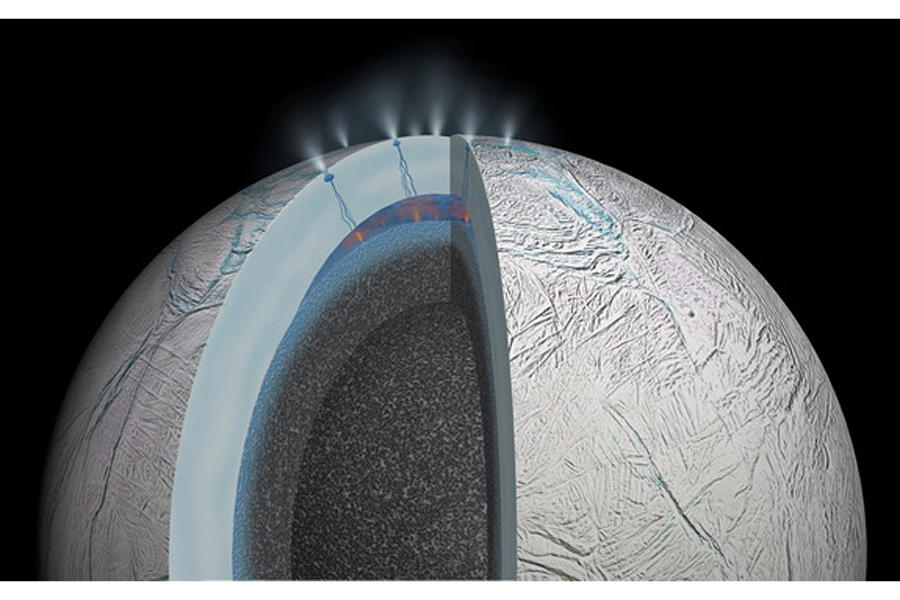On a moon of Saturn, a boiling ocean?
Loading...
Hot springs on Saturn's icy moon Enceladus suggest that the floor of the satellite's subsurface ocean may be home to near-boiling temperatures, researchers say.
This finding is the first evidence of active hydrothermal vents beyond the oceans of Earth. Moreover, conditions deep under the icy surface of Enceladus could be similar to those that gave rise to the first life on Earth, the researchers reported in the new study.
The sixth largest of Saturn's moons, Enceladus has a diameter of only about 314 miles (505 kilometers). This makes it small enough to fit inside the borders of Arizona. [Ocean Suspected Beneath Enceladus Ice (Video)]
Something brewing on Enceladus
Despite Enceladus' diminutive size, which helped shield it from discovery until 1789, this icy, tiny, shiny moon has drawn a great deal of attention due to its eruptions of water geysers, first seen by NASA's Cassini spacecraft in 2005. These water geysers suggest that Enceladus could host liquid water beneath its cracked frozen crust, making it one of the best potential sites for hosting life in the solar system.
Now, the new discovery of signs that hot springs may exist on Enceladus suggests these geysers are powered by hydrothermal activity, much like hydrothermal vents seen on Earth's seafloor. That makes Enceladus the first place outside Earth where researchers have detected ongoing hydrothermal activity, the scientists wrote in the new study, published in the March 12 issue of the journal Nature.
The investigators focused on the mysterious "stream particles," tiny dust particles that Cassini saw when it first approached Saturn about a decade ago. Analysis of these particles as they escaped from the region of Saturn into interplanetary space revealed that they were only nanometers (billionths of a meter) in size and rich in silica, in contrast to the ice-rich particles abundant around Saturn. Silica, or silicon dioxide, is extremely common on Earth, occurring mostly as quartz.
The research team's computer models of the paths of these mysterious particles suggest that they probably came from Saturn's E ring, a tenuous structure, made up mostly of small ice grains, between the orbits of Saturn's moons Titan and Mimas. The source of the particles in the E ring is Enceladus.
In lab experiments, the scientists found that the composition and 4- to 16-nanometer-wide size of the silica grains in the stream particles could have originated only under very specific physical conditions. These conditions include waters that could reach a temperature of at least 194 degrees Fahrenheit (90 degrees Celsius); depths of at least 24.8 miles (40 kilometers); a pH greater than 8.5, which is more alkaline than baking soda; and a salinity of less than 4 percent. For comparison, the vast majority of seawater on Earth has a salinity of 3.2 to 3.7 percent.
Enceladus' hot core
These findings suggest that Enceladus has an unexpectedly hot core given its tiny body, the researchers said.
"It is the existence of high-temperature rock-water reactions at the present time that surprises me the most, as we would expect Enceladus to be a frozen world," said study author Hsiang-Wen Sean Hsu, a planetary scientist at the University of Colorado, Boulder. "It means that there is still a big knowledge gap in understanding how solar system bodies evolve."
The main source of heat is probably an effect known as tidal heating, in which Saturn's gravitational pull deforms Enceladus strongly enough to heat rock, Hsu said. "However, this is not enough to sustain Enceladus' current level of heat output," Hsu told Space.com. Another potential source of heat during the early history of Enceladus could have been radioactive material, he added.
Such deep, hot, alkaline conditions are similar to those found on Earth in a deep-sea field of hydrothermal vents known as Lost City in the Atlantic Ocean, Gabriel Tobie, a planetary scientist at the University of Nantes in France, wrote in a commentary on these new findings in Nature. This hydrothermal field consists of 196-foot-tall (60 meters) limestone chimneys that vent alkaline fluid that is low in metals and lower-than-boiling in temperature. In contrast, most other known hydrothermal vents give off acidic fluid that's rich in metals and that's hotter than boiling, Tobie noted.
"Alkaline hydrothermal vents might have been the birthplace of the first living organisms on the early Earth," Tobie wrote.
"Hydrothermal systems could fulfill the three criteria to sustain life: energy, nutrients and liquid water," Hsu said. However, he said it was not clear if Enceladus was stable enough over geological timescales to allow life to evolve.
"There is no guarantee," Hsu said. "But the chances to find life are surely much better with active hydrothermal systems."
Follow us @Spacedotcom, Facebook and Google+. Original article on Space.com.
- 6 Most Likely Places for Alien Life in the Solar System
- Enceladus: Saturn's Refreshing Secret
- Saturn Quiz: How Well Do You Know the Ringed Planet?
Copyright 2015 SPACE.com, a Purch company. All rights reserved. This material may not be published, broadcast, rewritten or redistributed.







